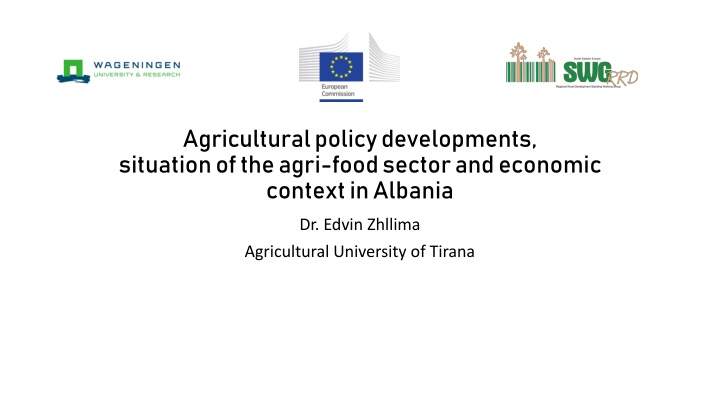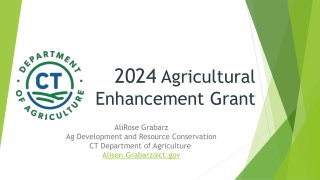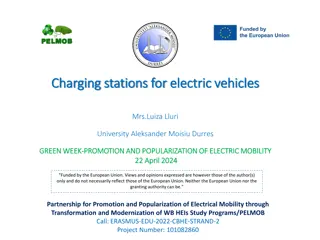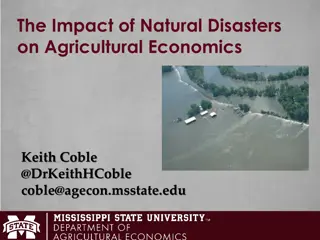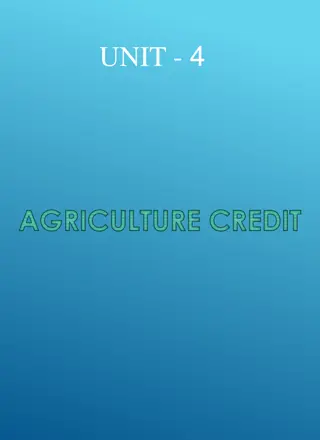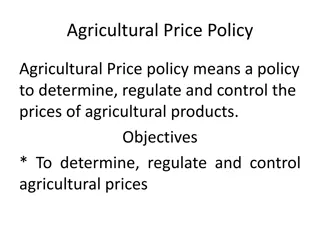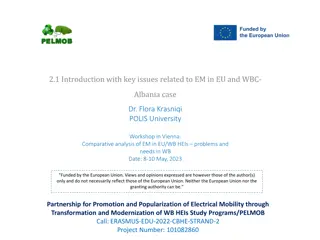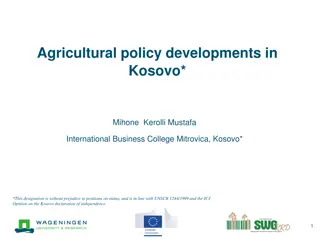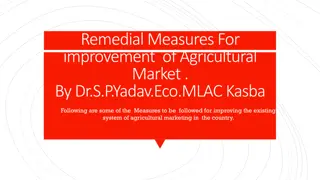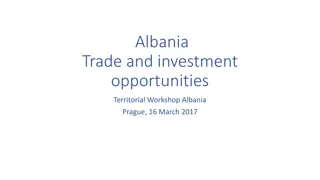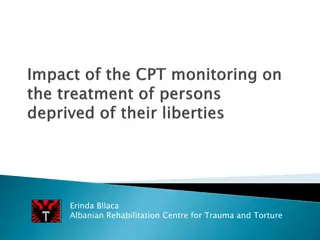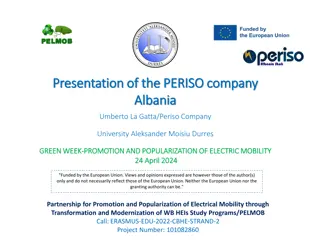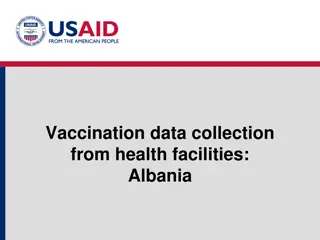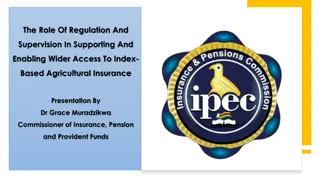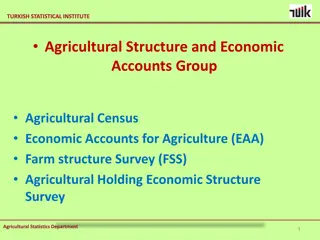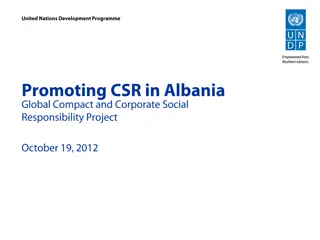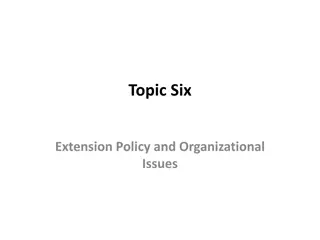1. "Agricultural Policy Developments in Albania
Agriculture, Policy, Albania, Rural Development, Economic Context
Download Presentation

Please find below an Image/Link to download the presentation.
The content on the website is provided AS IS for your information and personal use only. It may not be sold, licensed, or shared on other websites without obtaining consent from the author.If you encounter any issues during the download, it is possible that the publisher has removed the file from their server.
You are allowed to download the files provided on this website for personal or commercial use, subject to the condition that they are used lawfully. All files are the property of their respective owners.
The content on the website is provided AS IS for your information and personal use only. It may not be sold, licensed, or shared on other websites without obtaining consent from the author.
E N D
Presentation Transcript
Agricultural policy developments, situation of the agri-food sector and economic context in Albania Dr. Edvin Zhllima Agricultural University of Tirana
Structure Policy framework Measures and budgetary support of agriculture and rural development Covid 19 Greener policies EU aproximation Final remarks
Policy framework The agricultural sector in Albania is the largest in terms of importance to overall economy The main challenges for the Albanian agriculture remain: i. strengthening market orientation and competitiveness of the agri-food sector, ii. increasing the sector s response to social demands for safe, healthy, nutritious food and animal welfare iii. enhance farmers position in the food chain, iv. support climate change mitigation, v. foster sustainable management of natural resources and vi. guarantee community development and social capital in rural areas (MoARD, 2022).
Key legal, strategic and programming framework Key legal, strategic and programming document National Strategy for Agriculture and Rural Development 2021-2027 areas and iv. Foster sustainable maritime and aquaculture development Key goal and objectives Notes/remarks i.Reinforce a sustainable and competitive agri-food sector ii.environmental protection and climate actions, iii. Strengthen the socio-economic fabric of rural Under consultation process. IPARD III programme 2021- 2027 Reinforce a sustainable and competitive agri-food sector, strengthen environmental protection and climate actions and the socio-economicfabric of rural areas In process of documentation- Programme to be launched in 2023 In process of implementation. No clear indicative monitoring framework. Albanian National Land Consolidation Strategy (2016-2028) Assist farmers to improve farm structures by providing opportunities to reduce land fragmentation Law on LAGs (Local Action Groups) Provide basic principles, criteria, responsibilities, and processes for organizing and functioning of Local Action Groups Adopted. Preparatory work for the establishment of LAGs has started. Integrated Water Resources Management Strategy 2018-2027 Achieve the sustainable use of water resources, the attainment of good water quality in all water resources by the year 2027. Linked with the river basin management plans. Smart Specialisation Platform (S3P) Integrated Program for Rural Development-The 100+ villages initiative Yet not strongly related with other frameworks. Hybernating. Program implementation and the results achieved are unclear. Contribute to the Research and Innovation investments Coordinate development interventions in the rural area of 100 villages
Institutional and administrative policy framework Key institutions and administrative bodies Human capacities Human capacities competences needed upgrade Policy formulation Key role and responsibilities Other capacities 1-2 Ministry of Agriculture and Rural Development Responsible for policy formulation, execution and monitoring. Needs in terms of logistics 1-2 IPARD managing authority (within MARD) Responsible for IPARD preparation and monitoring. Policy monitoring and assessment Needs in terms of premisses Agriculture and Rural Development Agency Implementation of financial support measures Quality checks and monitoring Needs in terms of logistics and premisses 1-2 Albanian National Extension Service (ANES) Provision of advisory services and assistance for the farmers on applying for budgetary transfers. Needs in terms of logistics 1 New technologies Agriculture Technology Transfer Centers (ATTC) Transfer of technologies, research and advisory services including also farm managment and climate change mitgation/adaptation Inspection of food safety Need investments in laboratorial and logistics Need investments in laboratorial and logistics Need investments in laboratorial and logistics 1 New technologies National Food Authority (NFA) 2 New technologies National Authority of Veterinary and Plant Protection (NAVPP) Inspection of veterinary and plant protection 1 New technologies
Policy cycle management Policy cycle management De jure The SARDF 2021-2027 is planned to be transposed into the National Action Plan(for the same period), which should be detailed in the annual action plans. Each activity described in the yearly MoARD action plan is coded, assigned to a responsible body and aligned to a specific paragraphin the NPEI for 2021 2023. The annual action plan is reported by the MoARD to the Council of Ministers (CoM), Department for Monitoring of Legislation and Programmes (within CoM). The annual action plan, in line with the SARDF 2021 - 2027, provides the framework for setting up the ARDPF and the yearly support measures. De facto Gaps between policy formulation and its implementation, monitoring and evaluation during the period 2020 and 2021 yet not properly function. Weak level of capacities to monitor and adjust the policy design and implementation. No economic analyses unit within MARD Agriculture information systems and statistics in agriculture and rural development are in crisis
Measures and budgetary support of agriculture and rural development
Level of budgetary support for the agri-food sector in Albania during the period 2011 2021 60.0 2.50 50.0 2.00 40.0 Mill Euro % to GVA 1.50 30.0 1.00 20.0 0.50 10.0 0.0 0.00 2011 2012 2013 2014 2015 2016 2017 2018 2019 2020 2021 Budgetary support to agriculture (mill. EUR) Share of budgetary support to GVA (in %) Source: AL APMC database (2022), AL StatDatabase (2022).
Composition of budgetary support for the agri-food sector in Albania during the period 2011-2021 % 100% million EUR 60 90% Other measures related to agriculture 80% 50 70% 40 60% 50% Structural and rural development measures 30 40% 20 30% 20% 10 Market and direct producer support measures 10% 0 0% 12 13 14 15 16 17 18 19 20 21 12 13 14 15 16 17 18 19 20 21 Source: AL APMC database (2022).
Market and direct producer support in Albania during the period 2011 2021 million EUR % 12 100% 90% Disaster and other compensations 10 80% 70% 8 60% 6 50% Input subsidies 40% 4 30% 20% 2 10% Direct payments 0 0% 12 13 14 15 16 17 18 19 20 21 12 13 14 15 16 17 18 19 20 21 Source: AL APMC database (2022).
Budgetary support for structural and rural development during the period 2011 2021 % million EUR 100% 35 90% Rural economy and population 30 80% 25 70% 60% 20 50% Environment and societal services 15 40% 10 30% 20% 5 Competitiveness 10% 0 0% 12 13 14 15 16 17 18 19 20 21 12 13 14 15 16 17 18 19 20 21 Source: AL APMC database (2022).
Other measures related to agriculture in Albania during the period 2011 2021 million EUR % 12 100% 90% 10 Other general support 80% 70% 8 60% 6 50% Food safety 40% 4 30% 20% 2 R&D and expert services 10% 0 0% 12 13 14 15 16 17 18 19 20 21 12 13 14 15 16 17 18 19 20 21 Source: AL APMC database (2022).
Trend in budgetary support Overall support 1.8% of the GVA produced by the sector. Direct support is increasing to 20% of the overall support. Slightly more than 60% of the support is yet provided to single commodities, with focus on livestock commodities. Measures on headage payments for livestock and beekeeping, Another scheme that has experienced growth during 2020-2021 is the support measure for organic and certified organic farms (38%). Pessimist projections are expected for the future due to an increase again of the minimal size criteria for beneficiaries in te year 2022. A measure for establishment or reconstruction of spaces for rural tourism and investments in agro- tourism.
National scheme structure Agriculture and Rural Development Program sectors and products supported during the period 2017 2022 Major new policy instruments/measures introduced in 2020 and 2021 Year introduction 2020 2020 2020 2020 of New measure and policy significance Number of measure s 17 Year Sectors/products supported Global gap certification Reactivation of payments for organic conversion Payment for plantation of MAPs Provision of fuel as equivalent value to overall fuel tax exemption required for mechanical works on land. Greenhouse establishment Support of equipment and lines for the processing of olives, olive oil and medicinal and aromatic plants (MAPs) Investments for vessels purchase and modernisation Investments for the establishments of agriculture and live animals markets Seedling payment for vegetables and vineyards Support for digital farming Support for establishment of the center of excellence and innovation for production systems at Agricultural University of Tirana 2017 Five sectors 2018 Twelve sectors 2020 2021 52 2019 10 Five sectors 2022 2022 2020 7 Five sectors and one cross-sector 2022 2022 2022 2021 8 Five sectors and one cross-sector 2022 9 Six sectors and one cross-sector Technical assistance 2020
Main succeses and pending achievements Main successes and pending achievement of Main successes and pending achievement of agricultural policy instruments and measures agricultural policy instruments and measures Successes Notes Major impact is expected in terms of competitiveness, value chain strengthening, an increase in cooperation and an increase in sector self-sufficiency. Some support measures might be also beneficial for the livelihood of the rural population, the diversification of and support for natural resources such as the cultivation of orchards and MAPs, support for small ruminants, dairy cows and beekeeping, support for certification (organic, GlobalG.A.P. and ISO 2001 certification). . Pending achievements-challenges Suspension of payments based on output (milk premium payments and fish output payments) in 2020 Reduction of support measures Formulation of measures which cover the same subsector Introduction of tax exemptions support No use of area support Very low overall financing which do not fulfil the total number of successful applications Yet existing large support of single commodities measures Frequent change of minimum criteria for the headage support in livestock. No payments for environmental services and yet limited payments for the maintenance of rural economy and population Not existing decoupled support Area support yet not possible also Gradual increase of overall support Suspension plantation in 2020 Suspension on payments for plastic replacement in greenhouses in 2022 of payments for olive
IPARD contribution Overview of the measures, funds and number of applications in IPARD 2019-2020 Indicator M1 M3 No. of applications No. of approved applications EU contribution (th. EUR) National contribution (th. EUR) Total payments (th. EUR) EU allocated amounts (th. EUR) Notes Additional contributions to the total agricultural support in Albania comes from the EU s rural development component of pre-accession assistance The amount of disbursements for 2018-2020 was 3.5 Mln. By December 2021, 408 contracts were finalized in total for three calls where: a. 260 from the first call, with the grant amount. 22.62 Million euros, 78 from the second call, with the amount of the grant 21.94 million euros and 73 contracts in the third call, with the amount of the grant 8.64 Million euros. M4 M7 Total 643 220 194 1057 260 75 73 408 22.62 21.94 8.64 53.2 7.54 7.31 2.88 17.73 30.16 29.25 0 11.52 70.93 11 11.5183 2.55 25.068
Covid 19 impact Trends Trends Food supply chains in exports suffered disruptions, changing market demands and increasing transaction cost. Food losses increased in some sectors and reduced investments prospects for farmers and processors Reduced revenues at HoReCA, which caused lower demand for food and wine processors affected. Short delays were observed for routine agriculture services and temporary problems in accessing wholesale markets for small farmers. Reduction in income for off-farm labour and increased food security constraints, especially for staple foods. Diversity and quality of inputs were affected by border closures and arrears were witnessed in the sales. Measures Measures The support on wages for employees, which mainly affected the formalised entities. Provision of fuel support was implemented. Access to public services was still operational EC avoided time lags and losses of IPARD II programme funding at the end of 2020 (EC, 2021).
Greener policies The green economy concept was not thoroughly applied in any strategic framework in Albania before 2021 no National Green Economy or Sustainable Development Strategy. SARDF 2021-2027 provides special focus on activities relate to green economy development. Changes in the Law on Forest might enable activities of carbon footprint accumulation). Legal and institutional base is fragmented, with no institution in lead ((Ministry of Agriculture and Rural Development, Ministry of Tourism and Environment, Ministry of Infrastructure and Energy as well Ministry of Economy and Finance are all dealing with components of green economy). No consistent budgetary support measures for developing green economy. Potential share of funding designated to agriculture and rural development (less than 5%). Policy framework, legal frame and leading institutions and hyrearchy is required.
EU aproximation IPARD implementation in Albania continued in a satisfactory manner in terms of number of contracts signed as well as their corresponding contracted value. Measure M1. Investments in Physical Assets of Holdings M3. Investments in Physical Assets Processing Marketing of Agricultural, livestock and Products M7. Farm Diversification and Business Development M9.Technical assistance Status Accredited TBD Part of IPARD III in 2023 Agricultural Technical assistance measure (M9) was accredited in 2021. Part of IPARD III in 2023 Accredited Concerning In 2022 IPARD III programme has sent for official acceptance. and Of the 17 measures provided by EAFRD, 5 measures in 2024 Measure 4 (Agri-environment climate and organic farming measure), Measure 5 (Implementation of local development strategies LEADER approach) and Measure 10 (Advisory services). Fishery Part of IPARD III in 2023 Part of IPARD III in 2023 EBIT (possibly 2023) EBIT (possibly 2023) EBIT Accredited Accredited Main Main gaps Chapter 11: setting up the IACS components, ensure administrative capacity required to prepare the IPARD III, completing the legal frameworks and ensure institutional- administrative capacity on quality and organic production gaps M4. Leader and support of rural communities M11. Establishment protection of forests M10. Advisory services Manuals procedures prepared Manuals procedures prepared Manuals procedures prepared Manuals procedures prepared Manuals procedures ready To be designed To be designed of in and of in of M5. Environment protection and Organic farming M6. Rural infrastructure of EBIT For chapter 12, alignment of the EU acquis on official controls, animal and plant health. public of not In relation to Chapter 13, alignment of EU Common Fisheries Policy (CFP) and endorse a Regional Plan of Action for small-scale fisheries. M8. Training Measure M13. Innovation Measure
Final remarks Albania have a clear commitment to the EU integration It is ready to adopt the Strategy for Agriculture, Rural Development and Fishery (SARDF) 2021-2027. The level of support has been increasing in the period 2020-2021 with a clear trend of increase in the direct support. Gaps still exist in terms of the policy and institutional requirements for further alignment of Albania s agriculture and rural development policies with the CAP. Policy design should follow a standard policy cycle approach, which considers regulation for reducing policymakers discretion ARDPF should be more oriented toward provision of environmental services, the support to rural economy and populations, and climate change. MARD has a limited supporting policy environment in terms of institutional preparation.0IACS remain crucial A flexible regulatory base and a proper institutional framework is required.
